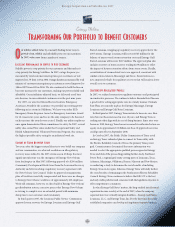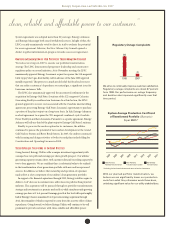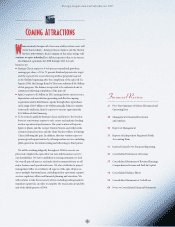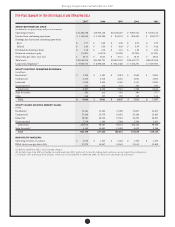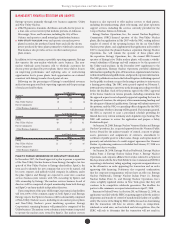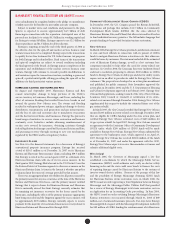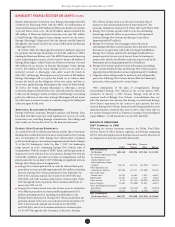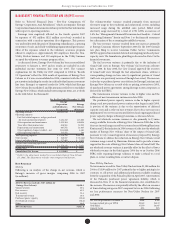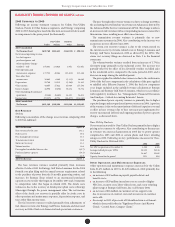Entergy 2007 Annual Report Download - page 25
Download and view the complete annual report
Please find page 25 of the 2007 Entergy annual report below. You can navigate through the pages in the report by either clicking on the pages listed below, or by using the keyword search tool below to find specific information within the annual report.
Entergy Corporation and Subsidiaries 2007
23
5. UN D E R S T A N D T H E SO C I A L EF F E C T S
At home and around the world, we cannot let the brunt of the damage –
economic and climatic – fall on the poorest among us. Policymakers will face
trade-os between reducing the costs of an emissions cap to the overall
economy and reducing the economic burdens to certain sectors or households.
Regardless of whether allowances are allocated or auctioned, consumers
will bear most of the cost of meeting an emissions cap and pay higher prices
for products like electricity and gasoline. us, carbon regulation has the
potential to have profound and adverse impacts on those who can least aord
it: our low-income customers. Energy price increases are regressive because
low-income households generally pay a higher percentage of their total
income for energy than do wealthier households. e need for intervention
should be obvious. For the poorest among us, the cost of reducing greenhouse
gas emissions could mean the loss of “luxuries” such as food, warmth and
shelter. is is unacceptable, particularly because children will feel the
greatest impact: Children who are hungry or cold cannot learn, and they
quickly fall behind their peers. Sacricing the future of impoverished children
for the welfare of future generations is a false choice and would be both a
disgrace and a disaster.
Ironically, those who hold out the false promise of cheap and easy solutions
to greenhouse gas control are doing no favors to the disadvantaged. Failure
to recognize how costly this will be will lead to the failure to protect against
its regressive eects. Bottom line, we need a stream of revenues directed to
mitigating the regressive eects, both nancial and climatic.
Our Generation’s Challenge
As a utility company serving coastal Louisiana and Texas, including New
Orleans, Entergy received a personal wake-up call from hurricanes Katrina
and Rita. ese storms dramatically demonstrated the unique risks that
climate change poses to our company and the communities we serve. Coastal
communities are already experiencing the adverse consequences of a rising
sea level and will be exposed to increasing risks from compounding climate
change factors over the coming decades.
Recognizing that we have a greenhouse gas problem, while important,
is actually the easy part of the job. Addressing the problem urgently yet
rationally is the hard part, and that is the challenge to which our generation
must respond.
e U.S. economy has been built upon a history of solving these kinds of
technical or technology problems. We have every reason to have condence
that this eort – in the United States and with the solutions applied globally –
will slow and stabilize the advance of climate change, thus justifying the
investment of money and resources in that eort. What is essential is political
will and tough-minded pragmatism, not false promises of cheap and easy
solutions. We need to have condence that the eort will really slow the
advance of global climate change and justify the enormous investment of
money and resources in the eort.
A smart carbon policy can protect the irreplaceable value of a clean, healthy environment.”
Cumulative CO2 Emissions 2006-2007
million tons
Actual
In 2006 and 2007, we performed better than the
stabilization goal we set as part of our second
voluntary commitment to stabilize our CO2 emissions
at 20 percent below year 2000 levels from 2006 to 2010.
Stabilization
Goal
85.1 79.0
Electric Power Research Institute Perspective
$ trillions in year 2000 dollars
Like the Electric Power Research Institute, we
believe that smart investment in advanced carbon
capture technologies is essential to reduce the
economic impact of any carbon policy.
Source:
“The Power to Reduce CO2 Emissions - The Full Portfolio”, discussion
paper prepared for the EPRI 2007 Summer Seminar by the EPRI
Technology Assessment Center.
Cost of Policy Reduction in Policy Cost
with Advanced Technology
Change in GDP Discounted rough 2050
($ trillions)
0.0
-0.5
-1.0
-1.5
Value of R&D Investment
Limited Portfolio
+ PHEV Only
+ Renewables Only
+ Efficiency Only
+ Nuclear Only
+ CCS Only
Full Portfolio


